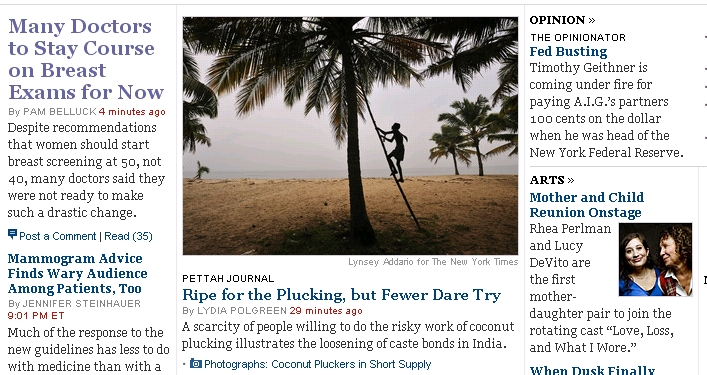
Ahem.
Excuse me.
While I cannot be entirely sure whether the current collection of bylines (and photo) are being intentionally funny or not, I would like to assure you that my boobs are not the wars in Iraq or Afghanistan.
However, I will grant you that smashing my boobs in a machine that tries to turn them into pringles every year in an effort to detect cancer seems painful and counterproductive – unless one is part of the boob-mashing industry which somehow manages to convince it’s victims to not only suck up this nasty treatment but also to PAY for it… I will admit that to that degree this barbaric process does, perhaps, bear some remote similarity to the wars in Iraq or Afghanistan.
One wonders whether Lady Liberty’s copper assets would meet a fate like this should some military/industrial complex savage decide that it would be profitable and necessary, in an Ayn Randian sort of way, to turn her front into pringles. It is bad enough that the huddled masses yearn to breathe free on the best of days. Frankly if it were me being menaced by some jackass with a pringle machine in the name of freedom, I’d find a new home for the torch.
Prior to this particular last few decades, this barbaric treatment of women did not occur, yet not as many women died from breast cancer because there were also other stupid things we weren’t doing, like using depleted uranium ammunition in our wars and allowing corporations to destroy our environment with radioactive and toxic waste.
Doctor it hurts when I do this. Don’t DO this. I am not in a hurry to turn my boobs into pringles again any time soon. There’s gotta be a better way. Pringle-smashing ain’t natural, it ain’t fun, and it doesn’t catch cancer any damn bit faster than a FREE, daily self examination.
Never again the pringle times. Troops home now. ;-7

19 comments
Skip to comment form
Author
Left, left, left right left…
‘fronts’ pringle-smashed. Of course, I haven’t had a pap since 1974 either. At which time the doc informed me that if I didn’t let him give me a total hysterectomy immediately, I’d be dead in six months.
But then again, I’m not at all sure that I’d go for the treatments that are ‘standard’ these days if I did have a lump. I might change my mind if I ever were in a position to actually get such treatment without having to sell the farm and impoverish my entire family first, I’m just not worth that much. Just me. I don’t trust the US medical system farther than I can throw it. I earned that distrust the hard way, and am not afraid enough of life or death to like being poked and prodded by strangers who view me as a slab of income-producing meat anyway. They don’t like me any better than I like them, so it’s okay. §;o)
In an American Cancer Society article from 2004, they cite a study by the Dutch that concluded an MRI was more sensitive
The same article article dismissed an MRI is women who were not high risk (previous abnormal mammogram, family history) mostly becasue of the cost and “false positives”
Now, my disagreement about the latter part of that statement is, how do you know it is a false positive unless you do further testing? What happened to erring on the side of caution in favor of the patient? Strawman, much?
One more little item. There is a bill pending in the House by Jerrold Nadler (D-NY) that would make a mammogram MRI available to women over 40
why have the test if you cant afford the cancer?
dont get me started.
up this morning on Orange by charliehall (with some hefty creds) on the study that led to this decision. Of course the new recs don’t apply to those in high risk categories, but to the pool of all (insured and/or wealthy) women between 40 and 50 who have been getting annual boob-squash-and-radiation tests. The data is fairly conclusive.
So predictably, the forever terrified Chicken Littles (they’re always afraid of something – anything – happening in the news today) aren’t so sure randomized statistic-keeping actually counts. One brags that she’s got 29 years’ experience in… radiologic testing and biopsy, who insists it’s a regular huge deal that women from 40-50 be regularly tested (and often biopsied for no reason due to false positives) because some women died in the not-tested group. That the same number of women also died in the tested group apparently is dismissible by someone who makes their living doing mammograms.
“Nobody wants to expose people to excess radiation,” she says, offering a bit of incredible irony to anyone who can tally doses from annual uncalled-for medical screenings exposure to excess radiation. As if we don’t know that radiation is itself a cause of cancer, which we DO know, and ten mammogram exposures added to 10 chest x-rays in the course of 10 years between 40 and 50 don’t statistically add up to X number of radiation-induced cancers in the deliberately exposed population.
But that’s the whole point! Check out The Cancer Market Outlook per the ever-profitable futures game…
Sick, sick, sick!